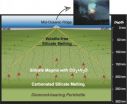(Press-News.org) Spin and bias exist in a high proportion of published studies of the outcomes and adverse side-effects of phase III clinical trials of breast cancer treatments, according to new research published in the cancer journal Annals of Oncology [1] today (Thursday).
In the first study to investigate how accurately outcomes and side-effects are reported in breast cancer trials, researchers at the Princess Margaret Cancer Centre and University of Toronto (Toronto, Canada) found that in a third of all trials that failed to show a statistically significant benefit for the treatment under investigation, the reports focused on other, less important outcomes in order to influence positively the interpretation of the results.
In two-thirds of the reports there was bias in the way adverse effects of the treatment were reported, with more serious side-effects (those with toxicities graded as III or IV) poorly reported. This was particularly the case in trials that showed a significant benefit for the treatment under investigation. Only 32% of articles gave details of the frequency of grade III or IV toxicities in the summary (known as the "abstract").
The authors of the study call for authors, journals and experts who review the articles for journals to be more rigorous in encouraging unbiased reporting of trial results and in enforcing guidelines.
Professor Ian Tannock, medical oncologist and senior scientist in the Division of Medical Oncology and Hematology at the Princess Margaret, who led the research, said: "Better and more accurate reporting is urgently needed. Journal editors and reviewers, who give their expertise on the topic, are very important in ensuring this happens. However, readers also need to critically appraise reports in order to detect potential bias. We believe guidelines are necessary to improve the reporting of both efficacy and toxicity."
Prof Tannock and his colleagues identified all randomised controlled, phase III clinical trials for breast cancer therapies that had been published between January 1995 and August 2011. Out of a total of 568 articles, 164 were eligible for inclusion in the analysis. Phase III trials usually evaluate the efficacy and/or the best dose for a particular therapy that has already been tested in earlier, small trials, and they usually involve more patients than phase I or II trials. Often, they are the final stage that a drug or other therapy has to pass before the treatment can be licensed for use in patients in normal clinical practice, outside of the trial setting.
Trials always have a "primary endpoint" – the specific event that is measured at the end of the trial to see whether or not the given treatment works. The primary endpoint is decided before the study begins. Often it relates to overall survival: did more patients survive or live longer on the new treatment than patients on the existing standard treatment? However, there can also be "secondary endpoints"; these are additional events that are of interest to the investigators, but which the study has not been designed specifically to address, and for this reason investigators have to be cautious in analysing and drawing conclusions from them. Secondary endpoints can include how much longer patients on the new treatment live without the disease progressing, spreading to other parts of the body or recurring, compared to patients on the standard treatment; what are the adverse side-effects and what is the quality of life.
Prof Tannock and his colleagues defined bias as "inappropriate reporting of the primary endpoint and toxicity, with emphasis on reporting of these outcomes in the abstract". They defined spin as "the use of words in the concluding statement of the abstract to suggest that a trial with a negative primary endpoint was positive based on some apparent benefit shown in one or more secondary endpoints".
They found that 54 (33%) trials were reported as positive, based on secondary endpoints, despite not finding a statistically significant benefit in the primary endpoint. "These reports were biased and used spin in attempts to conceal that bias," write the authors. They found that 58% of 92 trials that showed no benefit for patients from the experimental therapy (negative primary endpoint) used secondary endpoints to suggest benefit from the treatment.
A total of 110 (67%) of papers reported adverse side-effects of the experimental therapy in a biased manner. If a trial showed a benefit for the treatment (positive primary endpoint), then toxicities were more likely to be under-reported.
The first author of the study, Dr Francisco Vera-Badillo, clinical research fellow at the Princess Margaret, said: "We found a high incidence of biased reporting of the outcomes of clinical trials. In those with outcomes that were either negative or did not show a statistically significant benefit, spin was used frequently to influence positively the interpretation of the results, by focusing on apparent benefits from secondary endpoints.
"Where trials showed a positive outcome, the toxicities were less likely to be reported. A possible explanation for this could be that the investigators, sponsors or both, prefer to focus on the efficacy of the experimental treatment and downplay toxicity to make the results look more attractive."
The source of funding for trials (industry or academic) was not associated with bias or spin in the reporting of results and toxicities.
In order to be published in most academic journals, it is now compulsory to register clinical trials before they start. Many countries register them on either the USA registry (ClinicalTrials.gov) or the European registry (clinicaltrialsregister.eu). Some of the studies analysed for the Annals of Oncology paper started before registration became compulsory. However, for those that were registered, the researchers found that some changed the primary endpoint between registration and the report of the outcomes being published. "Among these trials, there was a trend towards change of the primary endpoint being associated with positive results, suggesting that it may be a strategy to make a negative trial appear positive," write the authors. "Trial registration does not necessarily remove bias in reporting outcomes, although it does make it easier to detect."
###
Notes:
[1] "Bias in reporting of endpoints of efficacy and toxicity in randomized clinical trials for women with breast cancer", by F.E. Vera-Badillo, R. Shapiro, A. Ocana, E. Amir, I.F. Tannock. Annals of Oncology. doi:10.1093/annonc/mds636
Spin and bias in published studies of breast cancer trials
2013-01-10
ELSE PRESS RELEASES FROM THIS DATE:
Particles of crystalline quartz wear away teeth
2013-01-10
This press release is available in German.
Dental microwear, the pattern of tiny marks on worn tooth surfaces, is an important basis for understanding the diets of fossil mammals, including those of our own lineage. Now nanoscale research by an international multidisciplinary group that included members of the Max Planck Institute for Evolutionary Anthropology in Leipzig has unraveled some of its causes. It turns out that quartz dust is the major culprit in wearing away tooth enamel. Silica phytoliths, particles produced by plants, just rub enamel, and thus have ...
First image of insulin 'docking' could lead to better diabetes treatments
2013-01-10
A landmark discovery about how insulin docks on cells could help in the development of improved types of insulin for treating both type 1 and type 2 diabetes.
For the first time, researchers have captured the intricate way in which insulin uses the insulin receptor to bind to the surface of cells. This binding is necessary for the cells to take up sugar from the blood as energy.
The research team was led by the Walter and Eliza Hall Institute and used the Australian Synchrotron in Melbourne, Australia. The study was published today in the journal Nature.
For more ...
Magma in mantle has deep impact
2013-01-10
HOUSTON – (Jan. 9, 2013) – Magma forms far deeper than geologists previously thought, according to new research at Rice University.
A group led by geologist Rajdeep Dasgupta put very small samples of peridotite under very large pressures in a Rice laboratory to determine that rock can and does liquify, at least in small amounts, as deep as 250 kilometers in the mantle beneath the ocean floor. He said this explains several puzzles that have bothered scientists.
Dasgupta is lead author of the paper to be published this week in Nature.
The mantle is the planet's middle ...
After decades of research, scientists unlock how insulin interacts with cells
2013-01-10
The discovery of insulin nearly a century ago changed diabetes from a death sentence to a chronic disease.
Today a team that includes researchers from Case Western Reserve University School of Medicine announced a discovery that could lead to dramatic improvements in the lives of people managing diabetes.
After decades of speculation about exactly how insulin interacts with cells, the international group of scientists finally found a definitive answer: in an article published today in the journal Nature, the group describes how insulin binds to the cell to allow the ...
GW researchers find variation in foot strike patterns in predominantly barefoot runners
2013-01-10
WASHINGTON –A recently published paper by two George Washington University researchers shows that the running foot strike patterns vary among habitually barefoot people in Kenya due to speed and other factors such as running habits and the hardness of the ground. These results are counter to the belief that barefoot people prefer one specific style of running.
Kevin Hatala, a Ph.D. student in the Hominid Paleobiology doctoral program at George Washington, is the lead author of the paper that appears in the recent edition of the journal Public Library of Science, or PLOS ...
A history lesson from genes
2013-01-10
When Charles Darwin first sketched how species evolved by natural selection, he drew what looked like a tree. The diagram started at a central point with a common ancestor, then the lines spread apart as organisms evolved and separated into distinct species.
In the 175 years since, scientists have come to agree that Darwin's original drawing is a bit simplistic, given that multiple species mix and interbreed in ways he didn't consider possible (though you can't fault the guy for not getting the most important scientific theory of all time exactly right the first time). ...
Study examines how news spreads on Twitter
2013-01-10
Nearly every major news organization has a Twitter account these days, but just how effective is the microblogging website at spreading news? That's the question University of Arizona professor Sudha Ram set out to answer in a recent study of a dozen major news organizations that use the social media website as one tool for sharing their content.
The answer, according to Ram's research, varies widely by news agency, and there may not be one universally applicable strategy for maximizing Twitter effectiveness. However, news agencies can learn a lot by looking at how their ...
Unnecessary antimicrobial use increases risk of recurrent infectious diarrhea
2013-01-10
The impact of antibiotic misuse has far-reaching consequences in healthcare, including reduced efficacy of the drugs, increased prevalence of drug-resistant organisms, and increased risk of deadly infections. A new study featured in the February issue of Infection Control and Hospital Epidemiology, the journal of the Society for Healthcare Epidemiology of America, found that many patients with Clostridium difficile infection (C. difficile) are prescribed unnecessary antibiotics, increasing their risk of recurrence of the deadly infection. The retrospective report shows ...
Flooding preparedness needs to include infection prevention and control strategies
2013-01-10
Flooding can cause clinical and economic damage to a healthcare facility, but reopening a facility after extensive flooding requires infection prevention and control preparedness plans to ensure a safe environment for patients and healthcare workers. In a study published in the February issue of Infection Control and Hospital Epidemiology, the journal of the Society for Healthcare Epidemiology of America, clinical investigators report key findings and recommendations related to the closure and re-opening of hospitals impacted by black-water floods. The guidance builds on ...
Faulty behavior
2013-01-10
PASADENA, Calif.—In an earthquake, ground motion is the result of waves emitted when the two sides of a fault move—or slip—rapidly past each other, with an average relative speed of about three feet per second. Not all fault segments move so quickly, however—some slip slowly, through a process called creep, and are considered to be "stable," or not capable of hosting rapid earthquake-producing slip. One common hypothesis suggests that such creeping fault behavior is persistent over time, with currently stable segments acting as barriers to fast-slipping, shake-producing ...



